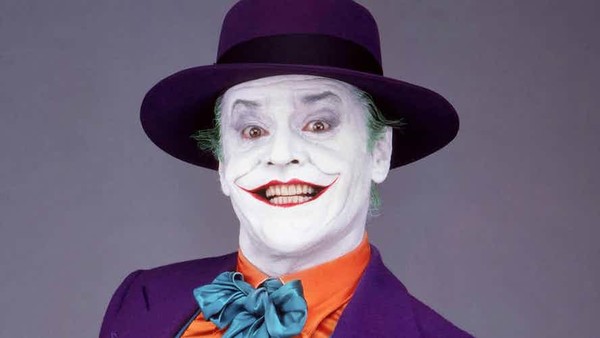The Evolution Of The Joker - Movie Timeline
4. Batman 1989

As with all of Burton's Batman universe characters, his Joker was at least partly coloured by his own experiences with so-called "acceptable society." He was an oddity himself to the degree that the British crew who welcomed him to the late 80s Batman set were baffled by him, not only by his inexperience (and perceived lack of credentials) but because of his gothic, "vagrant" look. No wonder he sought company in Gotham's freaks.
Unlike the 1960s Batman though, Burton adopted the idea of his Batman also being a freak. He was a monster who just happened to have a different motivation to the villains he sought to take down. And while some of those bad guys were sympathetic figures who were the product of their treatment (Penguin and Catwoman), it's no accident that the two who were most obviously malignant to their core were the most linked to corporate greed.
Burton's Joker has way more in common with Max Schreck than he does with Penguin. Sure, both live in the underworld, but Joker's aspirations are pinned more to consumerism than to acceptance and his vengeance at his transformation is merely a bolt-on to existing evil.
For a man who had frequently been accused of being a drug addict because of how he looked, whose quirks of personality were deemed strange and offensive and whose inner sweetness came as a surprise to those who initially judged him, Joker wasn't a horror movie monster. Because horror movie monsters were who Burton had grown up with, who he'd found kinship with. Batman is his horror movie monster - Joker is something else. He's a yuppie villain, wearing a suit even after his transformation, relying on commercials to spread his evil messages.
And more than that, Joker was a reflection of something more personal to Burton and a means to express the contradiction of his own image. He was an alien to his family, misunderstood by his father and mother and estranged from his brother, he was a young boy who sought comfort in the oddities of Vincent Price's works. That's why his work so frequently features stunted identities trapped in youth - Burton had a fear of growing up and for him, Joker was everything about growing up and following patterns that he hated.
This Joker is an instrument of mass order - he seeks not just to control Gotham's residents, but to transform them, as one, into his grotesque image. He's the very personification of corporate consumerism, forcing his brand on others as Batman stands up for individualism. Therein lies the fundamental dichotomy of the two. Bruce Wayne was Burton, a loner, isolated but fiercely committed to helping protect identities like his own, Joker was the personification of late 80s greed and the increasingly commodification of identity.
And again, it was contradiction that really captured Burton's imagination, right down to Joker's design, and in particular the contrast of his garish suit and deep red blood with his pale skin. All of that set him as Batman's binary opposite.
That idea might have ended up going through a serious filter by the time the Joker returned after the whole Schumacher debable, but Christopher Nolan's version was still based on Burton's agenda to "take the absurd and make it real"...
[CONTINUED on next page]